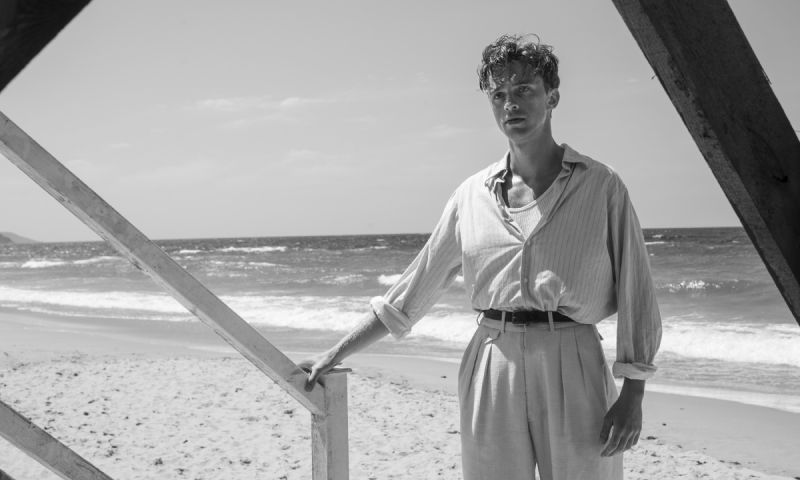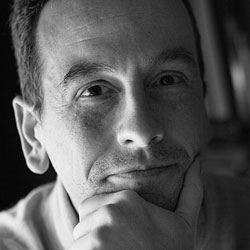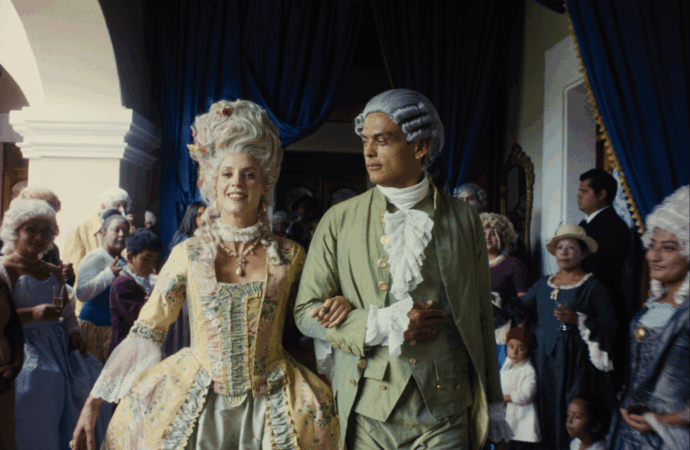Almost ten years have passed since François Ozon presented Frantz at the Venice Film Festival. His return to the Lido with L’étranger feels like an inevitable rendezvous: to confront Albert Camus is to engage in dialogue with a text that has fuelled philosophical, existentialist and political readings for decades. What is surprising is that Ozon does so with a sobriety that eschews both academic reverence and the temptation to artificially “modernise” the material. His staging is limited to following Meursault in his drift, observing how his apathy towards life, that indifference that has generated rivers of critical interpretations, gradually becomes a radical gesture, a way of being in the world that reveals the absurdity of social conventions.

Benjamin Voisin in L’étranger (François Ozon, 2025) © Foz – Gamount.
Benjamin Voisin embodies this strangeness with remarkable physical rigour: every lost gaze, every suspended gesture, makes the character’s opacity visible without the need for explanation. Instead of psychologising Meursault, he reduces him to a presence, to a body that moves oblivious to its surroundings. Rebecca Marder, for her part, offers a counterpoint full of vitality in Marie, a mixture of desire and vulnerability that illuminates the protagonist’s coldness and reveals the central contrast of the story: an impossible love in the face of a man incapable of reciprocating.
The black and white chosen by the French director and masterfully executed by Manu Decosse intensifies the timeless dimension of the story. It is not merely an aesthetic device: it accentuates the loneliness of the spaces, the isolation of the characters, the harshness of the situations. And within this visual sobriety, Ozon reserves a decisive device: the narrator’s voice, used only in the scene of the Arab’s murder and in the dénouement. There, Camus’ words resonate, without mediation, and this gesture of literary fidelity produces an almost cutting effect, as if the novel were suddenly filtering into the film.

Benjamin Voisin and Rebecca Marder in L’étranger © Foz – Gamount.
Acompañada por la música hipnótica de Fatima Al Qadiri, que mezcla ecos árabes y texturas electrónicas, la obra no busca clausura ni moraleja. Prefiere dejar al espectador en la misma intemperie en que Camus había situado a su protagonista: un lugar donde todo parece carecer de sentido y, sin embargo, la vida insiste en continuar.
Siempre en concurso se presentó Father Mother Sister Brother, donde Jim Jarmusch reafirma una vez más su fidelidad a un cine hecho de pausas, silencios y observación. Como en sus mejores trabajos anteriores, la acción queda en suspenso para dejar espacio a lo cotidiano, a los gestos que se repiten hasta volverse reveladores. El film se articula en tres episodios familiares que viajan entre Estados Unidos, Irlanda y Francia, con esa cadencia lenta y musical que convierte las aparentes rutinas en agobiantes rituales.
Accompanied by Fatima Al Qadiri‘s hypnotic music, which blends Arabic echoes and electronic textures, the work seeks neither closure nor moralising. It prefers to leave the viewer in the same exposed position in which Camus had placed his protagonist: a place where everything seems meaningless and yet life insists on continuing.
Also in competition was Father Mother Sister Brother, in which Jim Jarmusch once again reaffirms his fidelity to a cinema made up of pauses, silences and observation. As in his best previous works, the action is suspended to make room for the everyday, for gestures that are repeated until they become revealing. The film is structured around three family episodes that travel between the United States, Ireland and France, with a slow, musical cadence that turns apparent routines into oppressive rituals.

Vicky Krieps and Cate Blanchett in Father Mother Sister Brother © Yorick Le Saux.
The first two parts, Father and Mother, are among the director’s most accomplished recent films. In Father, the void between a distant father (played by singer Tom Waits) and two children (Adam Driver and Mayim Bialac) who are unable, for different reasons, to break through the wall of silence takes on a poignant depth: brief gestures, prolonged silences and elusive glances are charged with an emotional weight that disturbs and moves us more than any words could. In Mother, the staging achieves a rare precision: the coldness of a perfectionist mother (Charlotte Rampling) and the detachment of two very different daughters –played by Cate Blanchett and Vicky Krieps– coexist in a fragile balance, sustained by performers capable of infusing every pause with an inner vibration.

Luka Sabbat e Indya Moore in Father Mother Sister Brother © Carole Bethuel Vague Notion.
The Sister and Brother section, on the other hand, suffers from the weakness of the two young actors (Indya Moore and Luka Sabbat), who are unconvincing when it comes to sustaining the subtlety of the interwoven stories developed by the American filmmaker. The musicality of the staging is interrupted, and the episode feels more rigid and less capable of dialogue with the strength of the previous ones.
Gus Van Sant returns to the Mostra after more than thirty years of absence, and he does so with Dead Man’s Wire, presented out of competition. Inspired by a real event that took place in 1977, the film reconstructs the case of Tony Kiritsis, a man who, convinced that he had been swindled by his bank, took an executive hostage and tied a cable connected to the trigger of a sawed-off shotgun around his neck, demanding money and a public apology.

Bill Skarsgård and Dacre Montgomery in Dead Man’s Wire © Stefania Rosini.
The film moves between tense thriller and social commentary, showing how a desperate gesture can become an uncomfortable mirror of abuses of power. Van Sant, who has always alternated between risky projects and more classic narratives, achieves a balance between the two here with a direction that stands out for its varied style and restrained pace, avoiding sensationalism and focusing the tension on the silences, gestures and psychology of the characters.
However, beneath this hypnotic surface, the narrative is more schematic than expected: the story moves forward with intensity, but rarely manages to open up to a broader dimension, to those multiple readings that have sometimes characterised the director’s work. Bill Skarsgård offers a magnetic portrayal of Kiritsis, supported by a stellar cast that includes Dacre Montgomery, Colman Domingo and Al Pacino.









No one has posted any comments yet. Be the first person!